by Anja du Plessis
Ker & Downey Africa > Journal > Little Black Book of Southern African traditions and cultures to experience
The vast continent of Africa is home to over 1,100 species of mammals and 2,600 species of birds. Besides this rich array of fauna and flora, the continent also boasts over 54 countries, which are home to over 3000 different cultures, From the Maasai in East Africa to the “first men,” the San of Southern Africa, connecting with and spending time with the various Southern African traditions and cultures of the local people that call Africa home, expands visitor horizons in memorable and unexpected ways.
The Samara region was historically home to both San and Khoi people, the former being pastoralist sheep and cattle farmers and the latter being nomadic hunters and gatherers. The reserve is fortunate to be the guardian of various ancient cultural treasures. The most noteworthy example is a cave with rock art that includes a rare, meticulously preserved depiction of a cheetah or female lion surrounded by a few people, and some animals that appear to be elephants and giraffes.

In the interest of enjoying the paintings and their significance as cultural landmarks, guests staying at one of Samara’s lodges can trek up to the cave with a guide. Samara also has remnants of the more recent past of the Karoo region. In the 1780s, French explorer and naturalist Francois le Vaillant camped alongside the Plaat River, which cuts through the reserve. In his diary, he mentions the original buildings in the area that still stand to this day- 250 years later. South Africa is rich in history, and Samara is one of the special places guests can delve deeper into southern African traditions and cultures.
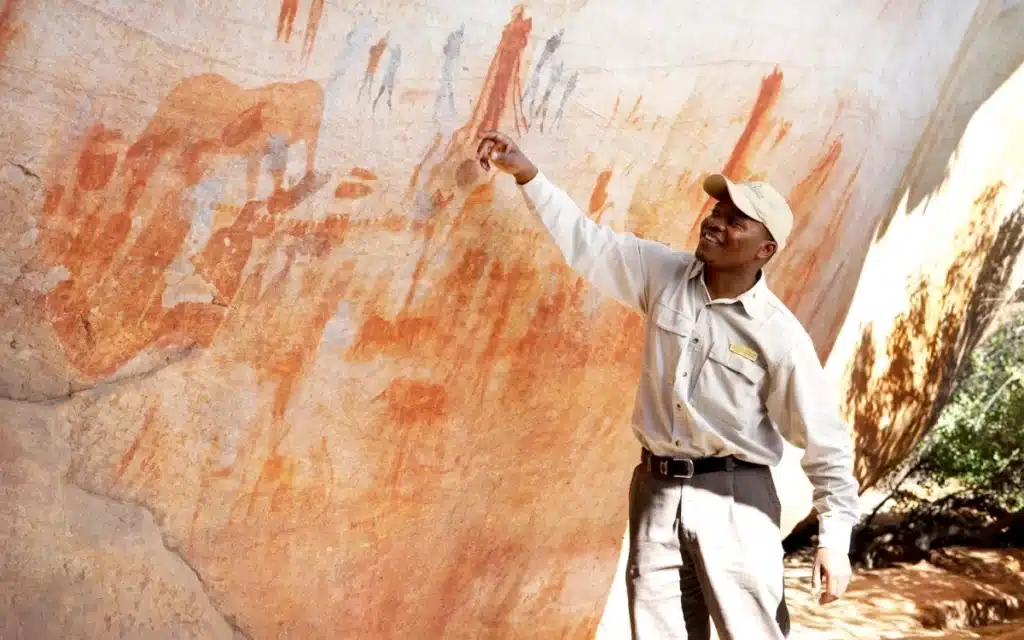
San tribes memorialized their culture, history, and shamanic visions on rocky overhangs using ochre, sap, and blood. These engravings capture both special occasions and their daily lives. The Cederberg region is where the San have made their home for millennia. These ancient pieces of art, some of which date back more than 10,000 years, are now the main attraction of any trip to Bushmans Kloof. This 7500-hectare reserve, has been designated a South African National Historic Site and safeguards more than 130 distinctive rock art monuments. Visitors are given a true sense of place by the rich tapestry of southern African cultures and traditions. The team at this luxury 5 star lodge is honored to be able to share these fragments of African cultures and traditions with visitors while also acknowledging the tremendous worth these ancient artworks hold in the nation’s cultural landscape. The Bushmans Kloof Heritage Centre also has a distinctive collection of artifacts, books, and photographs illustrating the San people’s culture and history. By maintaining historic traditional art, a significant component of Bushmans Kloof’s cultural legacy, the team directly advances the UN’s Global Goal 11 ‘Sustainable Cities and Communities,’ by preserving ancient traditional art, an important element of Bushmans Kloof’s cultural heritage.
The magnificent Organ Pipes, a remarkable geological phenomenon over 150 million years old, are located close to Twyfelfontein in the unique landscapes of Namibia. They include rich, rust-colored columns that rise over 5 meters above the ground and resemble a church organ. An elevated granite mass near the Organ Pipes, nicknamed “Fire Mountain” because of the sun’s red-glow effect on the granite massif, served as an exceptional landmark for early explorers. Nearby, the ‘White Lady’ Bushmen painting is located on Namibia’s tallest mountain, Brandberg Mountain. The rock art, which is exquisitely drawn on a small rock overhang and is buried in mystery and mythology, is thought to depict an elderly shaman who can predict the future and is encased in the mountain. A beautiful example of African traditions and cultures and the beliefs they held sacred from a bygone era.

Some of the best preserved Bushmen engravings can be found on the rocky outcrops of Twyfelfontein. Discover the one and only UNESCO World Heritage site in Namibia. The most extensive collection of rock art in Africa is enjoyed here – a National Monument since 1952. There are more than 2500 distinct rock carvings and paintings on 212 slabs of rock, plus 13 additional art rock slabs, some of which are considered to be more than 6,000 years old. We recommend exploring the art sites in the late afternoons on guided tours that include a stop at the visitor center, constructed from easily removable recycled material, that blends seamlessly with the beauty of the surrounding red sandstone. Namibia is rich with both historic and current-day African cultures and traditions and is most worthwhile exploring, whether you have a morning or a day to delve into the various offerings.
Come for the desert-adapted elephants, but stay for the rich community interactions at Damaraland Camp, situated in the Torra Conservancy. Since its debut in 1996, Damaraland Camp has been jointly owned and operated by the Torra Conservancy’s locals and a local safari group. The successful cooperative venture laid the groundwork for Namibia’s ground-breaking community-conservancy concept, which benefits rural residents by paving a balanced way for the community – and their livestock- to coexist with the area’s wildlife. As a result, the number of elephants, black rhinos, lions, and other endangered species has dramatically increased in the protected area, thereby stimulating tourism as well as the local economy through increased economic activity. A positive balance between conservation and community needs is increasingly being focused on in the area, beyond celebrating the rich local African cultures and traditions.
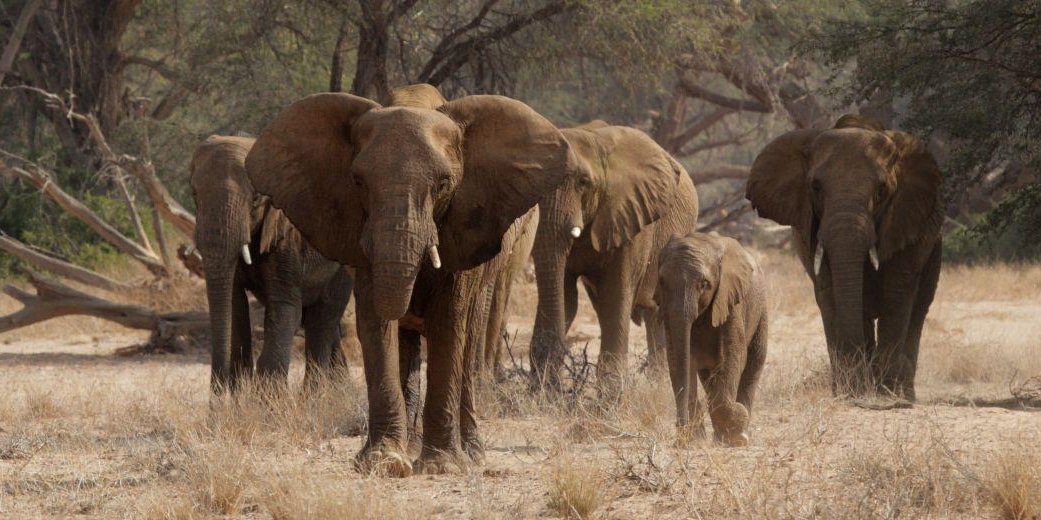
The option to visit nearby towns and learn about the distinctive legacy of the Nama-Damara, Herero, and Ovambo people is available to visitors, in addition to excursions to observe the remarkable local rock art and nature drives and hikes. A visit to a nearby farm at either Fonteine Pos or De Riet is also part of this excursion.
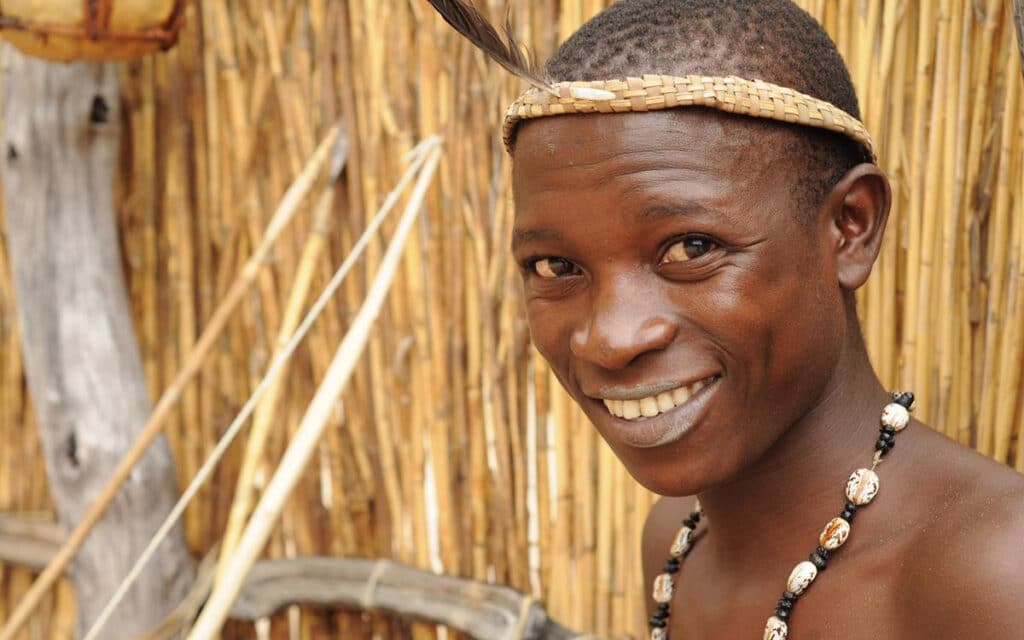
You can join a San adventure when you visit the Makgadikgadi Pans and Jack’s Camp Botswana to discover more about the Zu/’hoansi Bushmen’s culture and way of life. One of the world’s largest salt flats and a fascinating landscape of dry savanna can be seen at Botswana’s Makgadikgadi pans. Here, you may enjoy game drives into the Makgadikgadi National Park to view animals like lions, zebras, elands, and gemsbok, as well as Makgadikgadi specialties like brown hyenas and aardvarks. The Zu/’hoansi Bushmen’s experience is a unique, immersive one that will open your eyes and warm your heart to Africa’s cultures and traditions. From learning how the locals catch scorpions and guinea fowl and how to make a fire using only foraged fire starters, to the wonderful games and songs they share, this is a truly unforgettable experience.
Explore this incredible island’s northernmost lakes and sand dunes, stroll through the pews of the local church, built in part through donations from past guest visits, and engage with the local Mozambicans in their lively thatch-and-straw settlement. A fascinating visit to Centro Cumunitario Kanhe Kwedo, the local community center, exposes a remarkable community initiative where the men engage in conservation efforts and women explore their entrepreneurial creative spirits by crafting exquisite beaded goods.

Benguerra Island is covered with tall sand dunes that sparkle in the sunlight with the same warmth as the friendly local Mozambican people. Each trip is accompanied by a local expert who is well-versed in the island’s geography, history, and vibrant flora and fauna. The goal of guides is to provide you with an authentically local experience that is rich in southern African traditions and cultures.

A journey on the newly renovated Zambezi Queen is an unforgettable, luxurious safari experience. In addition to the abundance of opportunities for bird watching, game viewing, and fishing, there is also the wonderful opportunity to interact with the Sibuya tribe. On the East Caprivi floodplains, guests can take a lightweight boat to a nearby village in Namibia. Meet the elders and locals of the Subiya tribe hamlet to discover more about the people who live in this century-old community, including their daily challenges and customs.
Purchase a woven basket, some beaded jewelry, or a carved wooden animal as a memento of your journey; the proceeds from selling these items assist the villagers to financially support themselves through their small-scale businesses, all while sharing their rich African traditions and cultures. If guests would like to bring something along for the kids, then school supplies, books, or clothing are always welcome. At the end of this immersion, visitors will be treated to a wonderful display of traditional dancing and singing- sometimes even joining in on the fun and rhythm.
The Boma restaurant at Victoria Falls is famous for its lively experience and is a highlight on many safari journeys. From the moment you are ceremoniously clothed in your “chitenge” (sarong), to the traditional dance performances, and more, to the famed interactive drumming extravaganza, The Boma – Dinner & Drum Show is non-stop fun.
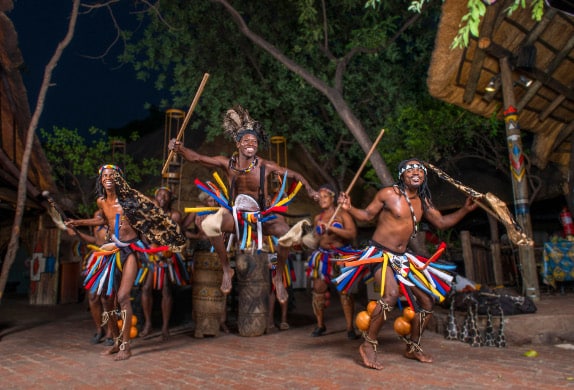
Adventurous guests can also choose to eat a mopani worm, get their faces painted and hair braided, or enjoy a spot of fortune telling the African way. The dinner features the traditional ‘braai’ or barbeque, and guests can expect a wide array of choice local dishes and delicacies. A very popular experience, this rich expression of African tradition and culture is made all the more memorable by being accessible and enjoyable to guests of all ages.
Visit a Zulu community near the &Beyond Phinda Private Game Reserve to get to know the big-hearted KwaZulu-Natal residents. The Zulu are South Africa’s largest ethnic group and a Bantu tribal group. A local &Beyond guide will lead you through the neighborhood while sharing wonderful stories and tales about the intriguing Zulu culture and its customs, beliefs, and traditions. Spend some time with the reputable community sangoma, a witch doctor and traditional healer who will discuss the role of the ancestors in Zulu life as well as the tribe’s spiritual beliefs and the value of their holy places. An evocative experience of one of the oldest African traditions and cultures, this visit is sure to leave guests with many wonderful memories.
Next, visit the Mduku Bakery to see how the Africa Foundation’s business development activities have impacted the neighborhood. Savor the tasty Amagwinya, a local Zulu specialty (or vetkoek, in Afrikaans).
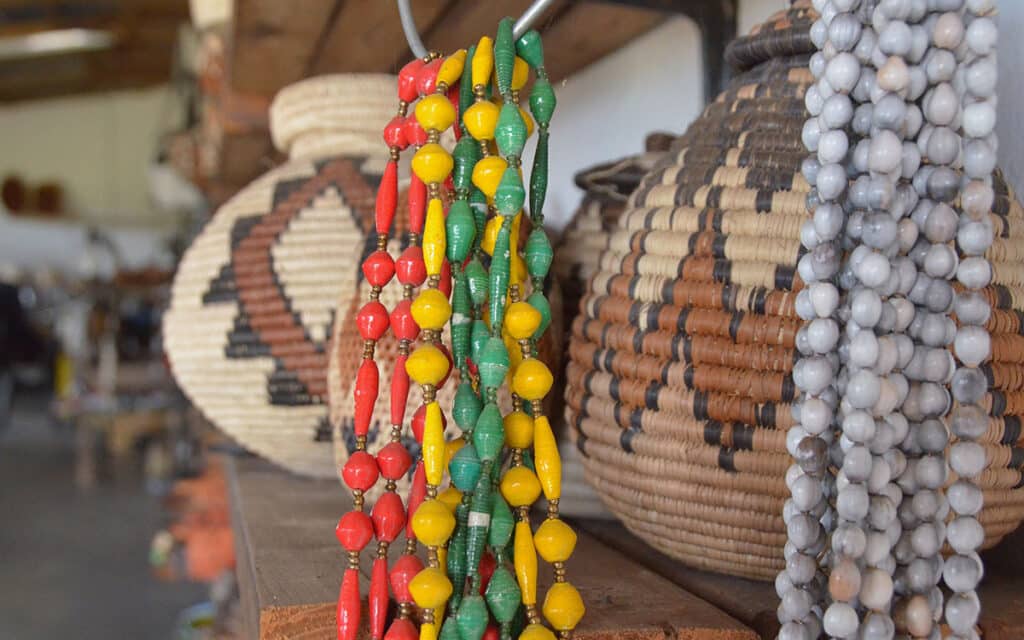
The journey comes to an end with a short stopover at the Mbhedula Craft Market, where 43 Zulu crafters’ magnificent creations are on display. You can get the perfect souvenir of your time spent with the Zulus there.
With so many southern African traditions and culture to encounter, experience, and enjoy our travel experts are ready to include as many of these captivating visits into your itinerary as you like.
See you out there!
Ker & Downey® Africa is compliant with COVID-19 Industry Protocols.


Head office: 7 Bree Street, 6th Floor, Touchstone House, Cape Town, South Africa
+27 (0)21 201 2484
[email protected]
United Kingdom: Sportsman Farm, St Michaels, Tenterden, Kent
Ker & Downey® Africa is compliant with COVID-19 Industry Protocols.